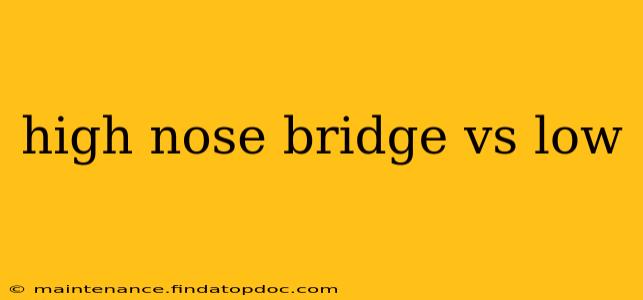A person's nose shape is a significant contributor to their overall facial features. While there's a wide spectrum of nose shapes, the distinction between a high nose bridge and a low nose bridge is a common point of discussion, particularly in the context of beauty standards and facial aesthetics. This article explores the key differences between these two nose bridge types, addressing common questions and misconceptions.
What is a High Nose Bridge?
A high nose bridge is characterized by a pronounced, prominent ridge between the eyes where the bridge of the nose meets the forehead. The angle between the bridge and the forehead is relatively steep. This feature is often associated with certain ethnicities, but it's crucial to remember that nose shape is diverse within and across populations. A high nose bridge is often described as adding a more defined and angular look to the face.
What is a Low Nose Bridge?
A low nose bridge has a less pronounced, flatter profile. The ridge between the eyes is less prominent, and the angle between the bridge and the forehead is gentler. Again, this is a spectrum, and the degree of prominence can vary significantly. A low nose bridge can create a softer, rounder appearance to the overall facial structure.
What Determines Nose Bridge Height?
The height of your nose bridge is primarily determined by genetics. Your parents' genetic makeup significantly influences the shape and structure of your nose, including the prominence of the nasal bridge.
Is One Nose Bridge Type More Attractive Than the Other?
Beauty standards are subjective and vary across cultures and time periods. There's no universally agreed-upon "more attractive" nose bridge type. Both high and low nose bridges can be considered beautiful, and the overall attractiveness of a nose depends on its proportions relative to the rest of the facial features. A well-proportioned nose, regardless of bridge height, generally contributes to facial harmony.
Can You Change Your Nose Bridge Height?
While you cannot fundamentally change the underlying bone structure of your nose without surgical intervention, there are some options to subtly alter the appearance of your nose bridge:
- Makeup: Contouring and highlighting techniques can create the illusion of a higher or lower nose bridge.
- Rhinoplasty: This surgical procedure can reshape the nose, altering the bridge height. It's crucial to consult a qualified plastic surgeon to discuss the risks and benefits.
Are There Health Implications Related to Nose Bridge Height?
The height of your nose bridge generally does not have significant health implications. However, a severely deviated septum (a crooked nasal cartilage partition) can affect breathing and may require medical attention. This condition is unrelated to the general height of the nose bridge, though.
How Does Nose Bridge Height Affect Glasses Fit?
The height of your nose bridge can influence the fit of your eyeglasses. Individuals with a high nose bridge may find that some glasses frames sit higher on their nose, potentially causing discomfort or slippage. Those with lower nose bridges may need frames with different nose pads to ensure a proper fit.
What are the Different Types of Nose Shapes?
Beyond the high and low bridge distinction, numerous other nose shapes exist. These include:
- Greek Nose: Straight profile with a slightly pointed tip.
- Roman Nose: Features a prominent, convex bridge.
- Aquiline Nose: Similar to a Roman nose, with a curved, hooked profile.
- Nubian Nose: Longer nose with a wide bridge and tip.
Ultimately, the diversity of nose shapes is a testament to human variation. Rather than focusing on arbitrary "better" or "worse" distinctions, appreciating the unique beauty of each nose shape is key.
